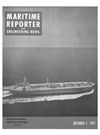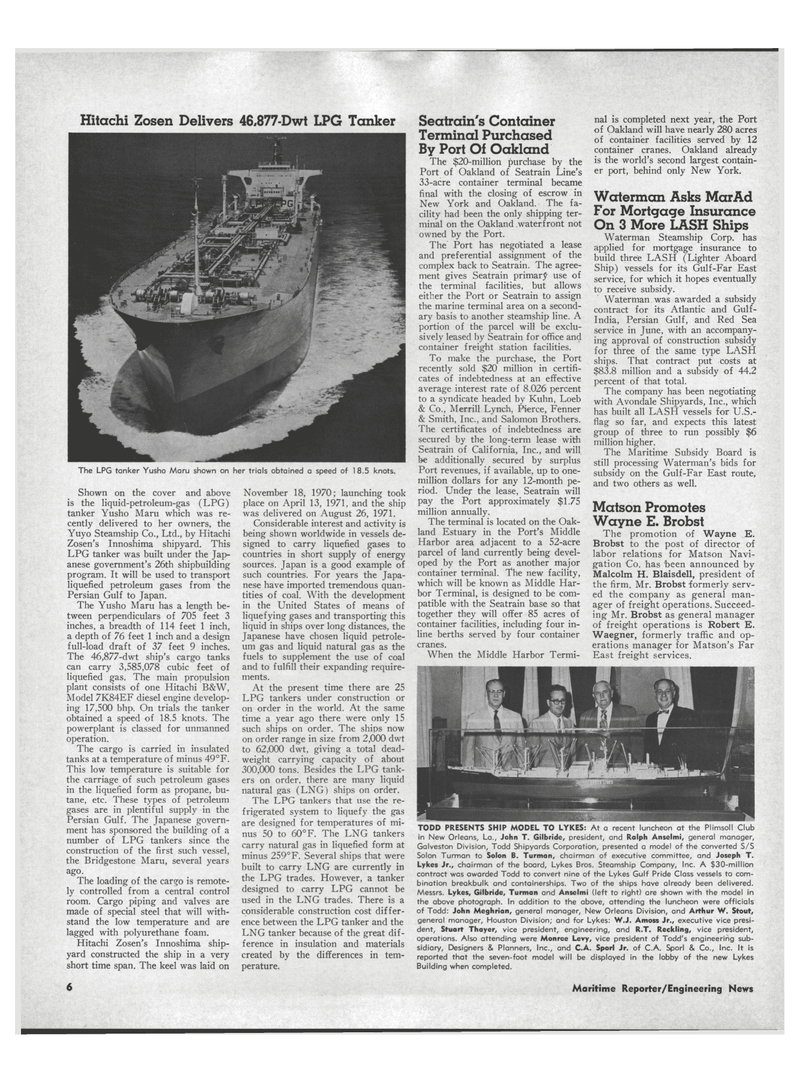
Page 4: of Maritime Reporter Magazine (October 1971)
Read this page in Pdf, Flash or Html5 edition of October 1971 Maritime Reporter Magazine
Hitachi Zosen Delivers 46,877-Dwt LPG Tanker
The LPG tanker Yusho Maru shown on her trials obtained a speed of 1 8.5 knots.
Shown on the cover and above is the liquid-petroleum-gas (LPG) tanker Yusho Maru which was re- cently delivered to her owners, the
Yuyo Steamship Co., Ltd., by Hitachi
Zosen's Innoshima shipyard. This
LPG tanker was built under the Jap- anese government's 26th shipbuilding program. It will be used to transport liquefied petroleum gases from the
Persian Gulf to Japan.
The Yusho Maru has a length be- tween perpendiculars of 705 feet 3 inches, a breadth of 114 feet 1 inch, a depth of 76 feet 1 inch and a design full-load draft of 37 feet 9 inches.
The 46,877-dwt ship's cargo tanks can carry 3,585,078 cubic feet of liquefied gas. The main propulsion plant consists of one Hitachi B&W,
Model 7K84EF diesel engine develop- ing 17,500 bhp. On trials the tanker obtained a speed of 18.5 knots. The powerplant is classed for unmanned operation.
The cargo is carried in insulated tanks at a temperature of minus 49°F.
This low temperature is suitable for the carriage of such petroleum gases in the liquefied form as propane, bu- tane, etc. These types of petroleum gases are in plentiful supply in the
Persian Gulf. The Japanese govern- ment has sponsored the building of a number of LPG tankers since the construction of the first such vessel, the Bridgestone Maru, several years ago.
The loading of the cargo is remote- ly controlled from a central control room. Cargo piping and valves are made of special steel that will with- stand the low temperature and are lagged with polyurethane foam.
Hitachi Zosen's Innoshima ship- yard constructed the ship in a very short time span. The keel was laid on
November 18, 1970; launching took place on April 13, 1971, and the ship was delivered on August 26, 1971.
Considerable interest and activity is being shown worldwide in vessels de- signed to carry liquefied gases to countries in short supply of energy sources. Japan is a good example of such countries. For years the Japa- nese have imported tremendous quan- tities of coal. With the development in the United States of means of liquefying gases and transporting this liquid in ships over long distances, the
Japanese have chosen liquid petrole- um gas and liquid natural gas as the fuels to supplement the use of coal and to fulfill their expanding require- ments.
At the present time there are 25
LPG tankers under construction or on order in the world. At the same time a year ago there were only 15 such ships on order. The ships now on order range in size from 2,000 dwt to 62,000 dwt, giving a total dead- weight carrying capacity of about 300,000 tons. Besides the LPG tank- ers on order, there are many liquid natural gas (LNG) ships on order.
The LPG tankers that use the re- frigerated system to liquefy the gas are designed for temperatures of mi- nus 50 to 60° F. The LNG tankers carry natural gas in liquefied form at minus 259°F. Several ships that were built to carry LNG are currently in the LPG trades. However, a tanker designed to carry LPG cannot be used in the LNG trades. There is a considerable construction cost differ- ence between the LPG tanker and the
LNG tanker because of the great dif- ference in insulation and materials created by the differences in tem- perature.
Seatrain's Container
Terminal Purchased
By Port Of Oakland
The $20-million purchase by the
Port of Oakland of Seatrain Line's 33-acre container terminal became final with the closing of escrow in
New York and Oakland. The fa- cility had been the only shipping ter- minal on the Oakland waterfront not owned by the Port.
The Port has negotiated a lease and preferential assignment of the complex back to Seatrain. The agree- ment gives Seatrain primary use of the terminal facilities, but allows either the Port or Seatrain to assign the marine terminal area on a second- ary basis to another steamship line. A portion of the parcel will be exclu- sively leased by Seatrain for office and container freight station facilities.
To make the purchase, the Port recently sold $20 million in certifi- cates of indebtedness at an effective average interest rate of 8.026 percent to a syndicate headed by Kuhn, Loeb & Co., Merrill Lynch, Pierce, Fenner & Smith, Inc., and Salomon Brothers.
The certificates of indebtedness are secured by the long-term lease with
Seatrain of California, Inc., and will be additionally secured by surplus
Port revenues, if available, up to one- million dollars for any 12-month pe- riod. Under the lease, Seatrain will pay the Port approximately $1.75 million annually.
The terminal is located on the Oak- land Estuary in the Port's Middle
Harbor area adjacent to a 52-acre parcel of land currently being devel- oped by the Port as another major container terminal. The new facility, which will be known as Middle Har- bor Terminal, is designed to be com- patible with the Seatrain base so that together they will offer 85 acres of container facilities, including four in- line berths served by four container cranes.
When the Middle Harbor Termi- nal is completed next year, the Port of Oakland will have nearly 280 acres of container facilities served by 12 container cranes. Oakland already is the world's second largest contain- er port, behind only New York.
Waterman Asks MarAd
For Mortgage Insurance
On 3 More LASH Ships
Waterman Steamship Corp. has applied for mortgage insurance to build three LASH (Lighter Aboard
Ship) vessels for its Gulf-Far East service, for which it hopes eventually to receive subsidy.
Waterman was awarded a subsidy contract for its Atlantic and Gulf-
India, Persian Gulf, and Red Sea service in June, with an accompany- ing approval of construction subsidy for three of the same type LASH ships. That contract put costs at $83.8 million and a subsidy of 44.2 percent of that total.
The company has been negotiating with Avondale Shipyards, Inc., which has built all LASH vessels for U.S.- flag so far, and expects this latest group of three to run possibly $6 million higher.
The Maritime Subsidy Board is still processing Waterman's bids for subsidy on the Gulf-Far East route, and two others as well.
Matson Promotes
Wayne E. Brobst
The promotion of Wayne E.
Brobst to the post of director of labor relations for Matson Navi- gation Co. has been announced by
Malcolm H. Blaisdell, president of the firm. Mr. Brobst formerly serv- ed the company as general man- ager of freight operations. Succeed- ing Mr. Brobst as general manager of freight operations is Robert E.
Waegner, formerly traffic and op- erations manager for Matson's Far
East freight services.
TODD PRESENTS SHIP MODEL TO LYKES: At a recent luncheon at the Plimsoll Club in New Orleans, La., John T. Gilbride, president, and Ralph Anselmi, general manager,
Galveston Division, Todd Shipyards Corporation, presented a model of the converted S/S
Solon Turman to Solon B. Turman, chairman of executive committee, and Joseph T.
Lykes Jr., chairman of the board, Lykes Bros. Steamship Company, Inc. A $30-million contract was awarded Todd to convert nine of the Lykes Gulf Pride Class vessels to com- bination breakbulk and containerships. Two of the ships have already been delivered.
Messrs. Lykes, Gilbride, Turman and Anselmi (left to right) are shown with the model in the above photograph. In addition to the above, attending the luncheon were officials of Todd: John Meghrian, general manager, New Orleans Division, and Arthur W. Stout, general manager, Houston Division; and for Lykes: W.J. Amoss Jr., executive vice presi- dent, Stuart Thayer, vice president, engineering, and R.T. Reckling, vice president, operations. Also attending were Monroe Levy, vice president of Todd's engineering sub- sidiary, Designers & Planners, Inc., and C.A. Sporl Jr. of C.A. Sporl & Co., Inc. It is reported that the seven-foot model will be displayed in the lobby of the new Lykes
Building when completed. 6 Maritime Reporter/Engineering News

 3
3

 5
5
